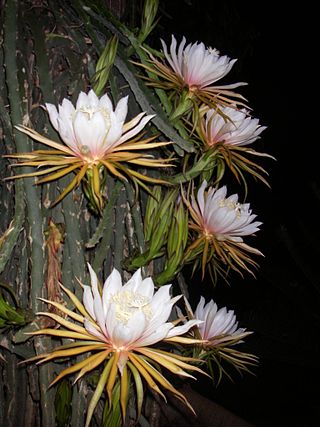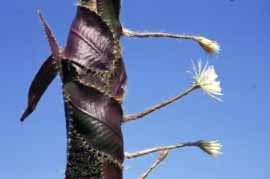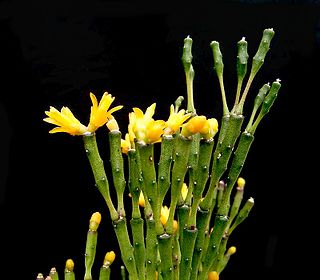
Schlumbergera is a small genus of cacti with six to nine species found in the coastal mountains of south-eastern Brazil. These plants grow on trees or rocks in habitats that are generally shady with high humidity, and can be quite different in appearance from their desert-dwelling cousins. Most species of Schlumbergera have stems which resemble leaf-like pads joined one to the other and flowers which appear from areoles at the joints and tips of the stems. Two species have cylindrical stems more similar to other cacti.

Disocactus is a genus of epiphytic cacti in the tribe Hylocereeae found in Central America, the Caribbean and northern South America. It should not be confused with Discocactus, which is a different genus.

Hylocereus is a former genus of epiphytic cacti, often referred to as night-blooming cactus. Several species previously placed in the genus have large edible fruits, which are known as pitayas, pitahayas or dragonfruits. In 2017, a molecular phylogenetic study confirmed an earlier finding that the genus Hylocereus was nested within Selenicereus, so all the species of Hylocereus were transferred to Selenicereus.

Selenicereus, sometimes known as moonlight cactus, is a genus of epiphytic, lithophytic, and terrestrial cacti, found in Mexico, Central America, the Caribbean and northern South America. The term night-blooming cereus is also sometimes used, but this is also used for many night-blooming cacti, including Epiphyllum and Peniocereus. In 2017, the genus Hylocereus was brought into synonymy with Selenicereus. A number of species of Selenicereus produce fruit that is eaten. The fruit, known as pitaya or pitahaya in Spanish or as dragon fruit, may be collected from the wild or the plants may be cultivated.

Pseudorhipsalis is genus of cacti. This genus is often included in Disocactus. It is epiphytic, many branched, and elongated with flattened, serrated cladodes. In its early life, it stands erect, but soon becomes prostrate. It produces numerous flowers.

Strophocactus is a genus of cacti in the subfamily Cactoideae. Its status and circumscription remain somewhat uncertain, with the genus containing one to three species. Molecular phylogenetic data suggest that it consists of three species, including two formerly comprising the genus Pseudoacanthocereus. With this circumscription, the species have different growth habits, but share similarities in their flowers, which are white and open at night.

Rhipsalis is a genus of epiphytic flowering plants in the cactus family, typically known as mistletoe cacti. They are found in parts of Central America, the Caribbean and northern regions of South America. They also inhabit isolated locations in Africa and Asia, and are the only cactus group naturally occurring in the Old World. This is the largest and most widely distributed genus of epiphytic cacti.

Hatiora is a small genus of epiphytic cacti which belongs to the tribe Rhipsalideae within the subfamily Cactoideae of the Cactaceae. Recent taxonomic studies have led to the three species formerly placed in subgenus Rhipsalidopsis being removed from the genus, including the well known and widely cultivated ornamental plants known as Easter cactus or Whitsun cactus.

Rhipsalidopsis is a small genus of flowering plant in the family Cactaceae, native to southern Brazil. Like other members of the tribe Rhipsalideae, its species are epiphytes, growing on trees.

The Cactoideae are the largest subfamily of the cactus family, Cactaceae. Around 80% of cactus species belong to this subfamily. As of August 2018, the internal classification of the family Cactaceae remained uncertain and subject to change. A classification incorporating many of the insights from the molecular studies was produced by Nyffeler and Eggli in 2010. Various revisions have been published since, e.g. to the tribe Hylocereeae and the tribe Echinocereeae. Classifications remained uncertain as of March 2019.

Strophocactus brasiliensis, synonym Pseudoacanthocereus brasiliensis, is a species of plant in the family Cactaceae. It is endemic to Brazil. Its natural habitats are subtropical or tropical dry forests and hot deserts. It is threatened by habitat loss.
Schlumbergera kautskyi is a species of plant in the family Cactaceae. It is endemic to a small area of the coastal mountains of south-eastern Brazil where its natural habitat is rocky areas. It is threatened by habitat loss. It is in the same genus as the popular houseplant known as Christmas cactus or Thanksgiving cactus.

The Rhipsalideae are a small tribe of cacti, comprising four or five genera. They grow on trees (epiphytes) or on rocks (lithophytes), where they either hang down or form creeping or upright shrubs. Their flowers open in the day and remain open at night; they may be either radially symmetrical (regular) or bilaterally symmetrical (zygomorphic). The fruits are berry-like, fleshy with smallish seeds.

Rhipsalidopsis gaertneri, synonyms Schlumbergera gaertneri and Hatiora gaertneri, is a species of epiphytic cactus which belongs to the tribe Rhipsalideae within the subfamily Cactoideae of the Cactaceae. Together with the hybrid with R. rosea, Rhipsalidopsis × graeseri, it is known, in English speaking countries in the Northern Hemisphere, as Easter cactus or Whitsun cactus and is a widely cultivated ornamental plant. It has received the Royal Horticultural Society's Award of Garden Merit.

The Hylocereeae are a tribe of cacti. Most are found in the tropical forests of Central and northern South America, and are climbers or epiphytes, unlike most cacti. The tribe includes between six and eight genera in different circumscriptions. The plants known as "epiphyllum hybrids" or "epiphyllums", widely grown for their flowers, are hybrids of species within this tribe, particularly Disocactus, Pseudorhipsalis and Selenicereus, less often Epiphyllum, in spite of the common name.

Hatiora salicornioides, the bottle cactus, dancing-bones, drunkard's-dream, or spice cactus, is a species of flowering plant in the cactus family. A member of the tribe Rhipsalideae, it often grows as an epiphyte, natively in eastern Brazil and ornamentally elsewhere.

Rhipsalidopsis rosea, synonyms Hatiora rosea and Schlumbergera rosea, is a species of flowering plant in the family Cactaceae, native to south Brazil. It was first described, as Rhipsalis rosea, by Gustaf Lagerheim in 1912. It is one of the parents of the hybrid Rhipsalidopsis × graeseri, grown as the Easter or Whitsun cactus.
Schlumbergera lutea, synonym Hatiora epiphylloides, is a species of flowering plant in the family Cactaceae, subfamily Cactoideae, native to southeast Brazil. It is a shrubby epiphyte, with flattened stems and bright yellow flowers.
Hatiora herminiae is a species of flowering plant in the tribe Rhipsalideae, family Cactaceae. It grows as an epiphyte in cloud forests in Southeast Brazil.

Deamia testudo is a species of flowering plant in the family Cactaceae, native from southern Mexico through Central America to Nicaragua. It was first described in 1838. It is a climber or clamberer, with long stems and large white flowers.
















